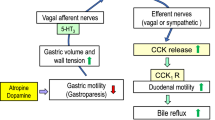Summary
This study was performed to investigate the mechanisms and significance of the intestinal phase of gastric secretion.
With infusion of 10% liver extract into the duodenum of dogs, serum gastrin levels of the right gastroepiploic vein increased significantly (p<0.01). With infusion of the pH 7.0 liver extract, acid and pepsin outputs in non-antrectomized dogs increased significantly (p<0.01), as did serum gastrin levels (p<0.01). Post-infusion acid output in these dogs was 48±16% of tetragastrin-stimulated output. With the same infusion, antrectomized dogs showed no significant increase of acid and pepsin outputs and serum gastrin levels. Acid output and serum gastrin levels in non-antrectomized dogs that were infused with pH 2.0 liver extract did not increase significantly. The values of almost all serum amino acids in both types of dogs increased slightly, but insignificantly, with pH 7.0 liver extract.
We obtained the following conclusions. The intestinal phase of gastric secretion operates by the mediation of the antral mucosa, from which gastrin is released. Although this phase has some effect, the acid-secretory ability of this phase is masked by inhibitory systems under certain physical conditions.
Similar content being viewed by others
References
Pavlov IP: The work of the digestion glands. Second edition Charles Griffin, London, 1910, p 110
Gregory RA, et al: The humoral stimulation of gastric secretion. J Exp Physi 31: 111, 1941
Grossman MI: The humoral stimulation of gastric secretion. Gastroenterology 67: 730, 1974
Debas HT, et al: Intestinal phase of gastric acid secretion. Gastroenterology 68: 691, 1975
Konturek SJ, et al: Characteristics of intestinal phase of gastric secretion. Am J Physiol 230: 335, 1976
Ihara O: Studies in intestinal phase of gastric secretion. J Jpn Surg Soc 83: 556, 1982 (Jpn)
Gordon L, et al: Serum gastrin during intestinal phase of acid secretion in dogs. Gastroenterology 77: 26, 1979
Isenberg JI, et al: Intravenous infusion of amino acids stimulates gastric acid secretion in man. N Engl J Med 298: 27, 1978
Landor JH, et al: Gastric secretory effect of amino acids given enterally and parenterally in dogs. Gastroenterology 73: 781, 1977
Report from the committee of the Japanese Society of Gastroenterology: Assay of peptic activity. Jpn J Gastroenterol 71: 207, 1974 (Jpn)
Sircus W: The intestinal phase of gastric secretion. Quart J Exptl Physiol 38: 91, 1953
Konturek SJ, et al: Intestinal phase of gastric secretion in patients with duodenal ulcer. Gut 19: 321, 1978
Isenberg JI, et al: Perfusion of the proximal small intestine with pepton stimulates gastric acid secretion in man. Gastroenterology 73: 746, 1977
Konturek SJ, et al: Stimuli for intestinal phase of gastric secretion in dog. Am J Physiol 234: E64, 1978
Jordan PH, et al: The regulatory effect of the pyloric gland area of the stomach on the intestinal phase of gastric secretion. Surgery 56: 121, 1962
Grabner P, et al: The intestinal phase of gastric secretion. Response to liver extract infusion into the proximal jejunum of healthy human subjects. Scand J Gastroenterol 11: 415, 1976
Watson LC, et al: Gastrin concentration in upper gastrointestinal mucosa in dog. Surgery 76: 419, 1974
Malmstrm J, et al: Gastrin in tissue. Concentration and component pattern in gastric, duodenal and jejunal mucosa of normal human subjects and patients with duodenal ulcer. Gastroenterology 70: 697, 1976
Bertaccini G, et al: Gastrin release by bombesin in dog. Br J Pharmac 52: 219, 1974
Polak JM, et al: Distribution of a bombesin-like peptids in human gastrointestinal tract. Lancet 22: 1109, 1976
Yanaihara C, et al: Bombesin-like immunoreactivity in mammarian tissue. Biochemical Research 1: 96, 1980
Dragstedt LR, et al: Quantitative studies on the mechanism of gastric secretion in health and disease. Ann Surg l32: 1950
Tompson JC, et al: Catabolism of gastrin andsecretin. World J Surgery 3: 469, 1979
Magee DF, et al: Pentagastrin stimulated pepsin secretion in man and dogs. Ann Surg 179: 300, 1971
Brooks AM, et al: The effect of secretin, glucagon and duodenal acidification on pepsin secretion in man. Gastroenterology 57: 159, 1969
Chey WY, et al: Secretin is an enterogastron in the dog. Am J Physiol 240: G239, 1981
Author information
Authors and Affiliations
Rights and permissions
About this article
Cite this article
Yagi, Y., Misumi, A. & Murakami, A. Role of antral mucosa in intestinal phase of gastric secretion in dogs. Gastroenterol Jpn 19, 24–33 (1984). https://doi.org/10.1007/BF02774643
Received:
Accepted:
Issue Date:
DOI: https://doi.org/10.1007/BF02774643




